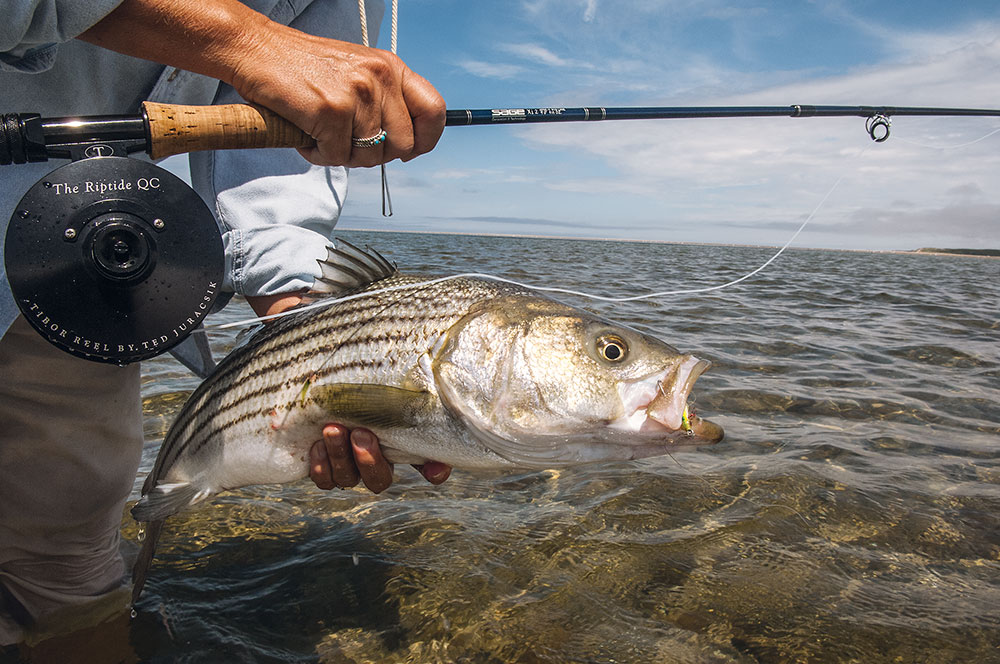
Creating a Tidal Clock System
In my opinion, the challenge that comes with fly-fishing for striped bass is what makes them such an addictive species to target. Once hooked, they pull extremely hard, which makes them quite a gamey combatant. They are available to anglers up and down nearly the entire East Coast as well as the West Coast’s San Francisco Bay and delta region. Their range spreads far and wide, since they can travel nearly one hundred miles in a single day. It is for this reason that saltwater fly-anglers love the game of hide-and-seek that striped bass seem to be so good at.
I am here to tell you that the key to becoming a successful striped bass angler is to fish what I call the tidal clock. Fishing the tidal clock is something that most professional fishing guides worth their salt practice day in and day out. While they may not talk about it publicly, believe me, they use it every day they hit the salt.
Learn the Tides
Tides repeat themselves twice a day over a 24-hour period. Each tide runs in a 12-hour cycle. It starts with the outgoing tide, which lasts for six hours. After that you have about a 45-minute to one-hour period of slack water. Then, after this slack period, the tide changes and the incoming tide begins and will last for the next six hours. After six hours of incoming water, another slack period follows, and then the entire cycle repeats itself. When detailing tides, we break the 12-hour cycle into six two-hour tidal stages. We start with the first two hours of the high outgoing tide. We call this stage the high out. The high out is followed by the next two-hour stage, which we call the middle out. The middle out is then followed by the last two hours of the outgoing tide, which we call the low out. Then the tide drops out and a period of slack water ensues until the incoming tide begins to roll in. The first two hours of the incoming tide is called the low in. The low in is followed by the middle of the incoming, which we call the middle in. The middle in is followed by the last of the incoming, which we term high in or flood tide. After that we get a slack period again for up to one hour before the process repeats itself all over again and the tide begins to recede again.
Putting Tides to Good Use
What anglers need to know is that fish feed in specific spots during particular stages of the tide. It is critical that you learn this if you want to become part of the 10 percent of the anglers who seem to catch 90 percent of the fish. The key to the tidal clock system is to have two or three productive fishing spots for each two-hour stage of the tide. For example, if you hear Joe Bodabing caught fish at spot A yesterday, but you don’t know in what stage the tide was when he caught the fish, you are not necessarily going to be successful when you go to spot A. Conversely, if you do know what particular stage the tide was in at spot A when the fish were caught, there’s a good chance you’ll find feeding fish — pay dirt!
A guide’s game plan is based on a mental road map that tells him where he will fish that day. That road map is basically predetermined based on the stage of the tide when they begin their day of fishing. Most guides will have two or three spots that produce on each stage of the tide and will run to each of those spots until they find fish. Once the tide moves toward the next stage, a guide will move to his or her next favorite spot that produces on that particular stage of the tide.
To start a tidal clock system is simple. First, gather information on your own and keep a detailed fishing log. List the date you fished as well as the name of the spot or spots you fished that day along with the time of the tide when you fished them. It’s also a good idea to include the wind direction, moon phase, what bait was present and whether you were successful or not. Over time, you will eventually accumulate a journal full of data that will tell you time and time again where you were successful and at what stage of the tide you caught your fish. Another way to hasten the learning curve is to share your information with a few other anglers, and between your network of buddies to develop a tidal clock that will bring you the successes. Once you have accumulated 15 to 18 productive fishing spots throughout a 12-hour tidal period, you will have just created a tidal clock. It may take a little time, but once your clock is completed, the next time you hit the suds for a few hours, all you need to do is look to see what stage the tide will be at when you decide to fish, and it will dictate where you are going to start. From there, follow your clock.
Building a Tidal Clock
To build a tidal clock, you need two disks that spin freely. The small inside disk notes the time of day by the hour. The outside disk lists the six stages of the tide and leaves room to enter your hot spots in the correct tidal stage. When you decide to go fishing, align the time of day with high tide in the area you intend to fish. Fish the hot spots on your tidal clock based on the stage of tide you will be fishing that day.









